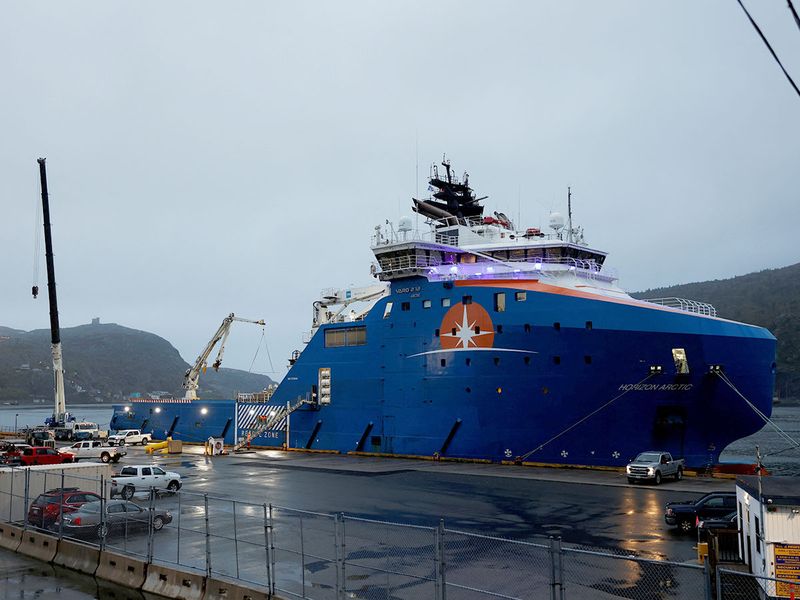
Highlights
- Clock ticks down on submersible's presumed air supply
- Titanic wreck lies in icy depths on Atlantic seabed
- Rescue teams from US, Canada, France join search
- 'Miracle' if passengers come out alive, says friend
- Canadian plane picks up underwater sounds as search expands
Washington: Rescuers searching for a missing submersible near the wreck of the Titanic on Wednesday concentrated their efforts on a remote area of the North Atlantic where a series of undersea noises have been detected, though officials cautioned the sounds may not have originated from the vessel.
With estimates suggesting the air supply on board the submersible could run out by Thursday morning, an international coalition of rescue teams has swept a vast expanse of the ocean for signs of the Titan, which disappeared on Sunday while taking five people deep into the ocean to visit the century-old wreck as part of a tourist expedition.
The US Coast Guard said remotely operated vehicle (ROV) searches were deployed in the area where Canadian aircraft recorded the noises using sonar buoys on Tuesday and Wednesday.
'Not sure what the noise was'
Coast Guard Captain Jamie Frederick said at a press conference that analysis of the noises has been "inconclusive." "We don't know what they are, to be frank with you," he said. "We're searching in the area where the noises were detected." Even if the submersible is located, retrieving it presents huge logistical challenges, given the extreme conditions miles below the surface.
This is a search and rescue mission, 100%. When you’re in the middle of a search and rescue case, you always have hope.
Teams from the United States, Canada and France have searched more than 10,000 square miles (25,900 square km) of open sea, roughly the size of Lebanon or the US state of Massachusetts.
The 22-foot (6.7-meter) submersible Titan, operated by US-based OceanGate Expeditions, began its descent at 8 a.m.
(1200 GMT) on Sunday. It lost contact with its parent surface vessel during what should have been a two-hour dive to the Titanic.
The submersible had 96 hours of air, according to the company's specifications, which would mean the oxygen could run out by Thursday morning. But experts say the air supply depends on a range of factors, including whether the submersible remains intact and still has power.
Search continues
Rescuers searched a vast swath of the North Atlantic for a third day on Tuesday, racing against time to find a missing tourist submersible that vanished while taking wealthy passengers on a voyage to the wreck of the Titanic in deep waters off Canada's coast.
The 21-foot-long Titan was built to stay underwater for 96 hours, according to its specifications - giving the five people aboard until Thursday morning before air runs out. One pilot and four passengers were inside the miniature sub early on Sunday when it lost communication with a parent ship on the surface about an hour and 45 minutes into its two-hour dive.
As Canadian and US authorities stepped up the search, previous questions about the safety design and development of the submersible by its owner, US-based OceanGate Expeditions, came to light.
The wreck of the Titanic, a British ocean liner that struck an iceberg and sank on its maiden voyage in April 1912, lies about 900 miles (1,450 km) east of Cape Cod, Massachusetts, and 400 miles (644 km) south of St. John's, Newfoundland.

US and Canadian aircraft have searched more than 7,600 square miles of open sea, an area larger than the state of Connecticut, US Coast Guard Captain Jamie Frederick told reporters at a press conference on Tuesday.
The Canadian military has dropped sonar buoys to listen for any sounds that might come from the Titan, and a commercial vessel with a remote-controlled deepwater submersible was also searching near the site, Frederick said.
Deep diving robot joins search
Separately, a French research ship carrying its own deep-sea diving robot vessel was dispatched to the search area at the request of the US Navy and was expected to arrive Wednesday night local time, the Ifremer research institute said.
also read
- How did the submersible go missing near the Titanic wreck?
- Pakistani billionaire and his son among five aboard missing Titanic submarine
- Hamish Harding is extraordinarily accomplished, says his company Action Aviation
- Read British expat in Dubai Hamish Harding's message just before Titanic site sub dive
5 aboard the sub
Those aboard Titan for a tourist expedition that costs $250,000 per person included British billionaire Hamish Harding, 58, and Pakistani-born businessman Shahzada Dawood, 48, with his 19-year-old son Suleman, who are both British citizens.
French explorer Paul-Henri Nargeolet, 77, and Stockton Rush, founder and CEO of OceanGate Expeditions, were also reported to be on board. Authorities have not confirmed the identity of any passenger.
Harding, a UAE-based businessman and adventurer who is chairman of Action Aviation, posted a message on Facebook on Saturday, saying: "This mission is likely to be the first and only manned mission to the Titanic in 2023." Fellow tourist Dawood is vice chairman of Engro, one of Pakistan's largest conglomerates.
![The missing 5: [From top-left] British billionaire Hamish Harding; French explorer Paul-Henri Nargeolet; Founder and CEO of OceanGate Expeditions Stockton Rush; Pakistani-born businessman Shahzada Dawood and his 19-year-old son Suleman.](https://imagevars.gulfnews.com/2023/06/21/The-missing-5---From-top-left--British-billionaire-Hamish-Harding--French-explorer-Paul-Henri-Nargeolet--Founder-and-CEO-of-OceanGate-Expeditions-Stockton-Rush--Pakistani-born-businessman-Shahzada-Dawood-and-his-19-year-old-son-Suleman.-_188dbe86799_original-ratio.jpg)
Rescuers face significant obstacles both in finding the Titan and in saving the people aboard, according to experts.
If the submersible experienced a mid-dive emergency, the pilot would likely have released weights to float back to the surface, according to Alistair Greig, a marine engineering professor at University College London. But absent communication, locating a van-sized submersible in the vast Atlantic could prove challenging, he said.
The submersible is sealed with bolts from the outside, preventing the occupants from escaping without assistance even if it surfaces.
If the Titan is on the ocean floor, a rescue effort would be even more challenging due to the extreme conditions more than 2 miles beneath the surface. The Titanic lies 12,500 feet (3,810 meters) underwater, where no sunlight penetrates. Only specialized equipment can reach such depths without being crushed by the massive water pressure.
"It's really a bit like being an astronaut going into space," said Tim Matlin, a Titanic expert. "I think if it's on the seabed, there are so few submarines that are capable of going that deep. And so, therefore, I think it was going to be almost impossible to effect a sub-to-sub rescue."
Safety issues raised before
The ability of the tourist sub's hull design to withstand such depths was questioned in a 2018 lawsuit filed by OceanGate's former director of marine operations, David Lochridge, who said he was fired after he raised safety concerns about the vessel.
OceanGate said in its breach-of-contract suit against Lochridge, who is not an engineer, that he refused to accept the lead engineer's assurances and accused him of improperly sharing confidential information. The two sides settled their court case in November 2018.
The company did not respond to requests for comment from Reuters and its attorney in the Lochridge case, Thomas Gilman, declined comment. An attorney for Lochridge declined comment except to say, "We pray for everyone's safe return." Months prior to the suit, a group of submersible industry leaders wrote to OceanGate warning that the "experimental" approach" to the sub's development could result in "minor to catastrophic" problems, the New York Times reported.
read more
- Titanic tourist submersible: Sheikh Hamdan prays for safe return of five missing passengers
- British expat from Dubai Hamish Harding among missing submersible crew near Titanic site
- Rescue teams search for missing submersible near Titanic wreck
- Video: Search intensifies for missing Titanic submersible
US President Joe Biden was "watching events closely," White House national security adviser John Kirby said on Tuesday. Britain's King Charles asked to be kept apprised of the search, a Buckingham Palace source said, as Dawood is a longtime supporter of the monarch's charity, the Prince's Trust International.
OceanGate said it was "mobilizing all options," and US Coast Guard Rear Admiral John Mauger told NBC News the company was helping to guide the search efforts.
"They know that site better than anybody else," Mauger said.
"We're working very closely with them to prioritize our underwater search efforts and get equipment there."
Weeklong summer missions
OceanGate schedules five week-long "missions" to the Titanic each summer, according to its website.
David Pogue, a CBS reporter, rode aboard the Titan last year. In a December news report, he read aloud the waiver he had to sign, which noted the submersible had "not been approved or certified by any regulatory body" and could result in death.
In an interview on Tuesday, Pogue said OceanGate has successfully ventured to the wreck around two dozen times and that the company conducts a meticulous safety check before each dive.
"They treat this thing like a space launch," he said.












